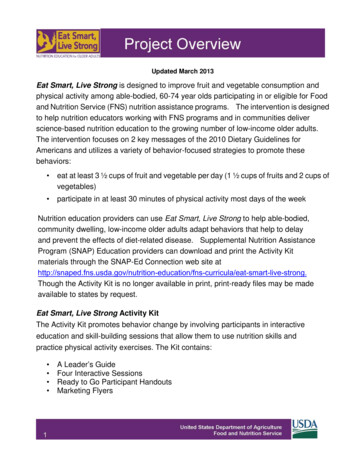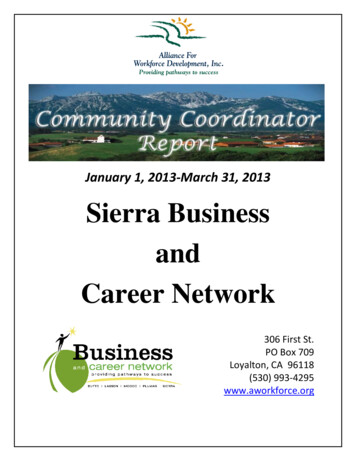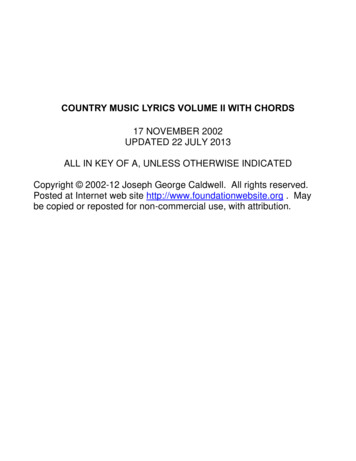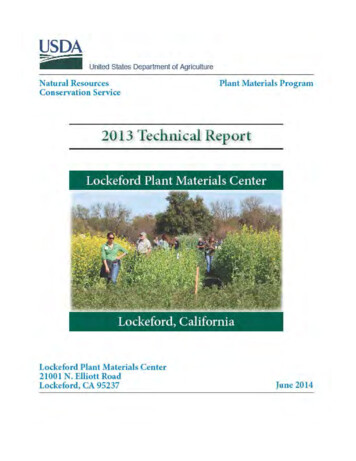
Transcription
Updated March 2013Eat Smart, Live Strong is designed to improve fruit and vegetable consumption andphysical activity among able-bodied, 60-74 year olds participating in or eligible for Foodand Nutrition Service (FNS) nutrition assistance programs. The intervention is designedto help nutrition educators working with FNS programs and in communities deliverscience-based nutrition education to the growing number of low-income older adults.The intervention focuses on 2 key messages of the 2010 Dietary Guidelines forAmericans and utilizes a variety of behavior-focused strategies to promote thesebehaviors: eat at least 3 ½ cups of fruit and vegetable per day (1 ½ cups of fruits and 2 cups ofvegetables) participate in at least 30 minutes of physical activity most days of the weekNutrition education providers can use Eat Smart, Live Strong to help able-bodied,community dwelling, low-income older adults adapt behaviors that help to delayand prevent the effects of diet-related disease. Supplemental Nutrition AssistanceProgram (SNAP) Education providers can download and print the Activity Kitmaterials through the SNAP-Ed Connection web site ns-curricula/eat-smart-live-strong.Though the Activity Kit is no longer available in print, print-ready files may be madeavailable to states by request.Eat Smart, Live Strong Activity KitThe Activity Kit promotes behavior change by involving participants in interactiveeducation and skill-building sessions that allow them to use nutrition skills andpractice physical activity exercises. The Kit contains: A Leader’s GuideFour Interactive SessionsReady to Go Participant HandoutsMarketing Flyers
The Leader’s Guide provides information and guidanceto help nutrition educators deliver and promote theintervention. It explains what the Kit activities aredesigned to accomplish and how they work. The Guideincludes information about the benefits of the behaviors,a review of the 2010 Dietary Guidelines for Americansrecommendations specific to older adults and materialsto promote Eat Smart, Live Strong to participants andtheir communities. Ideally, a trained nutrition educatorwill deliver all four sessions in sequence after reviewingthe Leader’s Guide. The sessions are designed to bedelivered in small groups of up to 10 participants. In addition, educators can reinforcethe behaviors by implementing the suggestions outlined in “MyPlate” and in the “Beyondthe Sessions” components of the Leader’s Guide.The Sessions are designed to motivate participants and build skills. Activities includeself-assessment tools to assist participants in achieving eating and physical activity goalsand simple standing and seated exercises. Eat Smart, Live Strong can be delivered inlocal communities through FNS programs such as SNAP, the Commodity SupplementalFood Program or the Senior Farmers’ Market Nutrition Program or through local sitessuch as senior and community centers.
Session 1, Reach Your Goals, Step by Stepallows participants to review the amount of fruitsand vegetables appropriate for their age, activitylevel and gender. This session encourages behavior change by providing participants with anopportunity to set goals and track achievement.Participant tools include a goal setting handout tomonitor progress and a self-assessment handout todetermine current fruit and vegetable intake andphysical activity levels. All four sessions include anexercise and a feedback sheet.
Session 2, Challenges and Solutions offersnumerous suggestions to help older adults adapttheir eating and physical activity behaviors to reachtheir goals. This session encourages behaviorchange by building participants’ ability to overcomechallenges and initiate support from health careproviders. Resources for participants include acommitment form and “Smart” card.
Session 3, Colorful and Classic Favoritesprovides hands-on experiences in updating classicrecipes by adding fruits and vegetables.Participants are encouraged to improve their skillsin creating healthier dishes by making simpleadaptations to familiar dishes. Easy-to-makerecipes are provided to help participants makeclassic dishes at home.
Session 4, Eat Smart, Spend Less increasesawareness about the variety of nutrition assistanceprograms available to low-income older adults.Educators are provided with strategies to helpparticipants identify resources within theircommunity to help them obtain fruits and vegetableson a limited budget.Developmental Process for Eat Smart, Live StrongDevelopment of the intervention involved several phases of formative research andtesting. FNS conducted a literature review to better understand the target audience, tailorthe intervention to provider and participant needs and identify evidence-based strategiesthat are effective with the target population. A review of promising practices was alsoconducted to identify relevant interventions and strategies.
The strategies, education methods, and activities highlighted in Eat Smart, Live Strongare based on findings from formative research. The BEHAVE decision framework wasused to guide the project, identify motivators to facilitate behavior change and selectappropriate activities. The materials were also field tested with nutrition educationproviders and participants to improve the clarity, relevance, and ease-of delivery.Demonstration ProjectsFNS encourages State and implementing agencies to plan and conduct demonstrationprojects to determine impact of the intervention on participants’ behaviors. Agenciesthat are interested in conducting a demonstration project should inform the FNSRegional SNAP and the State SNAP Education Coordinator in your state asappropriate. These materials were tested during the development process; however,FNS encourages efforts to assess the efficacy of the intervention in reaching specificoutcomes such as: increasing fruit and vegetable consumption increasing physical activity increasing use of community-based resources that improve access to fruit andvegetables or physical activity improving skills such as cooking, shopping or other precursors to the targetbehaviorsInclude details about plans for conducting demonstration projects as part of SNAPEducation plans. While FNS encourages use of traditional impact evaluation methods,other approaches are invited. Please refer to the current SNAP Education Guidance,available on the SNAP-Ed Connection at guidance-and-templates, for more information about evaluation options.
eat at least 3 ½ cups of fruit and vegetable per day (1 ½ cups of fruit s and 2 cups of vegetables) participate in at least 30 minutes of physical activity most days of the week Nutrition education providers can use . Eat Smart, Live Strong. to help able-bodied, community dwelling,











